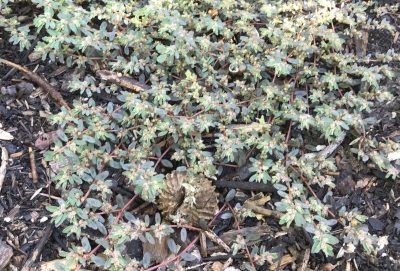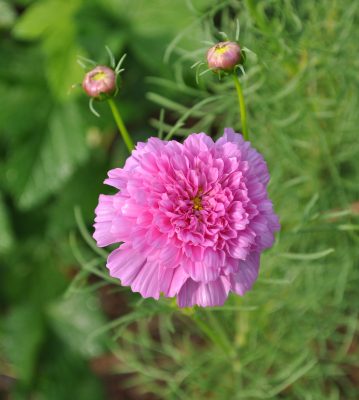Plants I Like
From Ancient Egypt
King Tut is alive and well, very well in fact. I’ll cut to the chase: This particular King Tut is a variety of papyrus (Cyperus papyrus) that I planted a year ago in spring. Papyrus doesn’t tolerate temperatures down to freezing, so this far north King Tut is billed as an annual. But rather than let the King die in winter, I was so smitten by him that in autumn I moved him in his pot indoors to a sunny window. There he clung to life and, with warm, sunny weather, got growing again this past spring.
In contrast to regular papyrus, which grows 5 to 9 feet tall, King Tut’s claim to fame is that he’s a dwarf, billed as rising 4 to 6 feet high. My King Tut only gets about 3 feet high.  All papyrus have a very distinctive and attractive appearance. The base of the plant is a clump of grassy leaves from which rise tall, leafless stalks which are capped by grassy-leaved mopheads looking something like the ribs of an umbrella. A houseplant relative of papyrus, Cyperus alternifolius, is commonly called umbrella plant.
All papyrus have a very distinctive and attractive appearance. The base of the plant is a clump of grassy leaves from which rise tall, leafless stalks which are capped by grassy-leaved mopheads looking something like the ribs of an umbrella. A houseplant relative of papyrus, Cyperus alternifolius, is commonly called umbrella plant.
Many, if not most, problems with plants in general can be attributed to too much or too little water. King Tut (and umbrella plant) are very easy to grow because they love water up around their ankles. All the plant needs is a deep saucer in which the pot can sit, with the saucer kept full of water. Not that King Tut demands water around his ankles. It’s just that consistently moist soil is needed, which means close attention to watering or standing in a water-filled saucer.
King Tut grows very rapidly, so this spring I divided the one King Tut plant into two and potted each one up separately. I also cut back all the old stalks. Although I tossed them in the compost pile, I could have made them into sandals, a boat, paper, or any one of the other papyrus products of ancient Egypt.
A Nice Weed
A few weeds garner my respect and my affection. Over the past few weeks, spotted spurge (Euphorbia maculate) has become one such weed. Spotted spurge has mouse-ear sized leaves, each with a reddish blotch along part of its main vein, and the leaves line up in a very orderly manner along the stems.  The definitive identifier for this weed is the way the stems spread out, flat, on top of the ground. In sun, no part of the plant rises more than a half an inch above ground level.
The definitive identifier for this weed is the way the stems spread out, flat, on top of the ground. In sun, no part of the plant rises more than a half an inch above ground level.
Mostly, I see spotted spurge growing in the wood-chip mulched paths in my vegetable garden. The amazing thing about this plant is the way it keeps sprouting in the paths. Even during the dry weeks of last June, spotted spurge kept sprouting. Not that it doesn’t also turn up following recent rains and in the irrigated, planted beds. I can’t help but respect a plant that can keep showing up under such adverse conditions.
Whenever I see the flattened stems, I reach down and pull it out, roots and all. My affection for this plant comes from the ease with which it is removed. The stems don’t form roots where they touch ground, as many other plants do, so grabbing the center of the clump gets rid of a square foot of weeds in one fell swoop. How satisfying.
Removing the plants is important. Spotted spurge is a summer annual that thrives in heat. Left alone, tiny flowers in each leaf axil give rise to tiny seeds that germinate through summer or, when weather warms, next year. It’s important not to dawdle in removing the plants because only a couple of weeks of growth are needed before young plants are old enough to flower and make seeds.
From Cosmos
I’m not usually a big fan of flower breeders’ new and wondrous creations, such as blue roses or tulips that look like peonies or peonies that look like tulips. That said, I’m quite enthralled with some cosmos I planted this spring that have been bred to look not very cosmo-ish.
What I’ve always liked about cosmos is their lack of pretension. The flowers are simple and sit singly atop tall stalks of sparse but feathery leaves. So along comes cosmos Rose Bon Bon.  As a cosmos fan, I figured I’d try Rose Bon Bon in spite of the fact that the flowers are double, which means they have multiple rows of petals. More complex and, hence, less cosmo-ish.
As a cosmos fan, I figured I’d try Rose Bon Bon in spite of the fact that the flowers are double, which means they have multiple rows of petals. More complex and, hence, less cosmo-ish.
Rose Bon Bon flowers, all of them soft pink, are beautiful. They’re still cheery, just like regular cosmos, frilly and cheery in this case. The name Rose Bon Bon notwithstanding, they do NOT look like roses.


Thank you for the King Tut post. I’m excited to know I might be successful in overwintering the adorable plants inside!